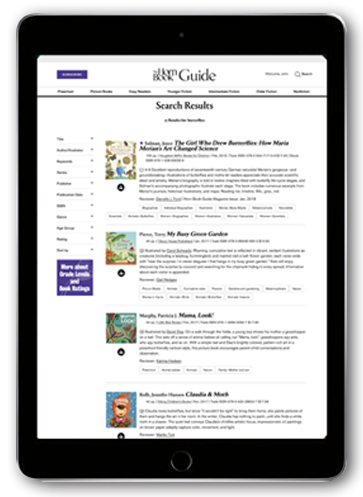Related
237 Reviews
(4)
4-6
Illustrated by
Tom Nick Cocotos.
A hodgepodge of trivia, illustrated with photographs and odd collages, this book probably won't really enable young readers "to distinguish what is real and what is fake," although it may help underscore the notion that you can't believe everything you read/see. It may also provide a diversion as kids browse the "fun facts," "wacky headlines," and more in a handy small trim size. Ind.
Reviewer: Cyrisse Jaffee
(3)
YA
Essential Library of the Information Age series.
Who owns and can regulate the internet? How has social networking affected privacy? How can kids evaluate the legitimacy of what they read? These questions and more are examined in this series that addresses weighty issues raised by internet technologies of our information age. Color photos and informative sidebars complement the straightforward and balanced narratives. Reading list, websites. Bib., glos., ind. Review covers the following Essential Library of the Information Age titles: Big Data and Privacy Rights, Net Neutrality, Content Ownership and Copyright, Book Banning and Other Forms of Censorship, Information Literacy in the Digital Age, and Online Identity.
Reviewer: Katrina Hedeen
(3)
YA
Essential Library of the Information Age series.
Who owns and can regulate the internet? How has social networking affected privacy? How can kids evaluate the legitimacy of what they read? These questions and more are examined in this series that addresses weighty issues raised by internet technologies of our information age. Color photos and informative sidebars complement the straightforward and balanced narratives. Reading list, websites. Bib., glos., ind. Review covers the following Essential Library of the Information Age titles: Big Data and Privacy Rights, Net Neutrality, Content Ownership and Copyright, Book Banning and Other Forms of Censorship, Information Literacy in the Digital Age, and Online Identity.
Reviewer: Katrina Hedeen
(3)
4-6
Searchlight Books: What Is Digital Citizenship? series.
Each volume addresses middle-grade kids directly, suggesting practical moves (skim websites to determine usefulness), warnings (never plagiarize), and critical thinking (what is the website's purpose: to inform or advertise?). Cautions about personal safety, appropriate language and sites, spam, and other issues are firm but not frightening. Color photos show kids using computers, laptops, and smartphones alone and with adults. Reading list, websites. Glos., ind. Review covers the following Searchlight Books: What Is Digital Citizenship? titles: Digital Safety Smarts, Smart Internet Surfing, Smart Online Communication, and Smart Online Searching.
Reviewer: Gail Hedges
(3)
4-6
Searchlight Books: What Is Digital Citizenship? series.
Each volume addresses middle-grade kids directly, suggesting practical moves (skim websites to determine usefulness), warnings (never plagiarize), and critical thinking (what is the website's purpose: to inform or advertise?). Cautions about personal safety, appropriate language and sites, spam, and other issues are firm but not frightening. Color photos show kids using computers, laptops, and smartphones alone and with adults. Reading list, websites. Glos., ind. Review covers the following Searchlight Books: What Is Digital Citizenship? titles: Digital Safety Smarts, Smart Internet Surfing, Smart Online Communication, and Smart Online Searching.
Reviewer: Gail Hedges
(3)
4-6
Searchlight Books: What Is Digital Citizenship? series.
Each volume addresses middle-grade kids directly, suggesting practical moves (skim websites to determine usefulness), warnings (never plagiarize), and critical thinking (what is the website's purpose: to inform or advertise?). Cautions about personal safety, appropriate language and sites, spam, and other issues are firm but not frightening. Color photos show kids using computers, laptops, and smartphones alone and with adults. Reading list, websites. Glos., ind. Review covers the following Searchlight Books: What Is Digital Citizenship? titles: Digital Safety Smarts, Smart Internet Surfing, Smart Online Communication, and Smart Online Searching.
Reviewer: Gail Hedges
(3)
4-6
Searchlight Books: What Is Digital Citizenship? series.
Each volume addresses middle-grade kids directly, suggesting practical moves (skim websites to determine usefulness), warnings (never plagiarize), and critical thinking (what is the website's purpose: to inform or advertise?). Cautions about personal safety, appropriate language and sites, spam, and other issues are firm but not frightening. Color photos show kids using computers, laptops, and smartphones alone and with adults. Reading list, websites. Glos., ind. Review covers the following Searchlight Books: What Is Digital Citizenship? titles: Digital Safety Smarts, Smart Internet Surfing, Smart Online Communication, and Smart Online Searching.
Reviewer: Gail Hedges
(3)
K-3
Kids Get Coding series.
Illustrated by
Alex Westgate.
A basic introduction to computers, coding, and programming for savvy young readers. Although illustrated with juvenile cartoons, graphs and charts require elementary math beyond arithmetic and the content can be fairly advanced. Still, the authors clearly define important terms and concepts (e.g., algorithm, cookies, bytes, metadata, debug, syntax), and offer quizzes and a website with other activities for young coders. Glos., ind. Review covers the following Kids Get Coding titles: Coding, Bugs, and Fixes, Learn to Program, Online Safety for Coders, and A World of Programming.
Reviewer: Jack Forman
(3)
K-3
Kids Get Coding series.
Illustrated by
Alex Westgate.
A basic introduction to computers, coding, and programming for savvy young readers. Although illustrated with juvenile cartoons, graphs and charts require elementary math beyond arithmetic and the content can be fairly advanced. Still, the authors clearly define important terms and concepts (e.g., algorithm, cookies, bytes, metadata, debug, syntax), and offer quizzes and a website with other activities for young coders. Glos., ind. Review covers the following Kids Get Coding titles: Coding, Bugs, and Fixes, Learn to Program, Online Safety for Coders, and A World of Programming.
Reviewer: Jack Forman
(3)
K-3
Kids Get Coding series.
Illustrated by
Alex Westgate.
A basic introduction to computers, coding, and programming for savvy young readers. Although illustrated with juvenile cartoons, graphs and charts require elementary math beyond arithmetic and the content can be fairly advanced. Still, the authors clearly define important terms and concepts (e.g., algorithm, cookies, bytes, metadata, debug, syntax), and offer quizzes and a website with other activities for young coders. Glos., ind. Review covers the following Kids Get Coding titles: Coding, Bugs, and Fixes, Learn to Program, Online Safety for Coders, and A World of Programming.
Reviewer: Jack Forman
(3)
K-3
Kids Get Coding series.
Illustrated by
Alex Westgate.
A basic introduction to computers, coding, and programming for savvy young readers. Although illustrated with juvenile cartoons, graphs and charts require elementary math beyond arithmetic and the content can be fairly advanced. Still, the authors clearly define important terms and concepts (e.g., algorithm, cookies, bytes, metadata, debug, syntax), and offer quizzes and a website with other activities for young coders. Glos., ind. Review covers the following Kids Get Coding titles: Coding, Bugs, and Fixes, Learn to Program, Online Safety for Coders, and A World of Programming.
Reviewer: Jack Forman
(4)
4-6
Checkerboard Library: Social Media Sensations series.
In ten or eleven brief chapters, each volume covers a social network's history, features, primary audience, and uses for businesses and charitable causes. The texts are accessible if dry; sidebars and stock photos (many featuring diverse young people enjoying their devices) add visual interest. An at-a-glance guide to the network, including quick facts and safety tips, is appended. Timeline. Glos., ind. Review covers the following Checkerboard Library: Social Media Sensations titles: Facebook, Instagram, Twitter, YouTube, Snapchat, Flickr, Pinterest, and Vine.
Reviewer: Katie Bircher
(4)
4-6
Checkerboard Library: Social Media Sensations series.
In ten or eleven brief chapters, each volume covers a social network's history, features, primary audience, and uses for businesses and charitable causes. The texts are accessible if dry; sidebars and stock photos (many featuring diverse young people enjoying their devices) add visual interest. An at-a-glance guide to the network, including quick facts and safety tips, is appended. Timeline. Glos., ind. Review covers the following Checkerboard Library: Social Media Sensations titles: Facebook, Instagram, Twitter, YouTube, Snapchat, Flickr, Pinterest, and Vine.
Reviewer: Katie Bircher
(4)
4-6
Checkerboard Library: Social Media Sensations series.
In ten or eleven brief chapters, each volume covers a social network's history, features, primary audience, and uses for businesses and charitable causes. The texts are accessible if dry; sidebars and stock photos (many featuring diverse young people enjoying their devices) add visual interest. An at-a-glance guide to the network, including quick facts and safety tips, is appended. Timeline. Glos., ind. Review covers the following Checkerboard Library: Social Media Sensations titles: Facebook, Instagram, Twitter, YouTube, Snapchat, Flickr, Pinterest, and Vine.
Reviewer: Katie Bircher
(3)
4-6
This guide for curious tweens promotes critical thinking through a series of very loosely organized questions, accompanied by well-documented trivia, quotes from students, and extension activities. Emphasizing speculation, the book offers springboards for discussion in or outside the classroom. It supports its broad-ranging questions with explanations that make complex topics accessible and may inspire further inquiry.
Reviewer: Dorrie Karlin
(4)
YA
Digital Issues series.
Although the surveys, statistics, and other data will soon be dated, this series is a thorough look at serious concerns of our digital world, from hacking to violent video games to overreliance on social media. Many of the topics overlap and are covered by more than one title. Text boxes, quotations, and stock photos help to break up the dense texts. Reading list, websites. Ind. Review covers these Digital Issues titles: Online Predators, Online Security, Online Addiction, Online Entertainment, Online Privacy, and Social Media.
Reviewer: Cyrisse Jaffee
(4)
YA
Digital Issues series.
Although the surveys, statistics, and other data will soon be dated, this series is a thorough look at serious concerns of our digital world, from hacking to violent video games to overreliance on social media. Many of the topics overlap and are covered by more than one title. Text boxes, quotations, and stock photos help to break up the dense texts. Reading list, websites. Ind. Review covers these Digital Issues titles: Online Predators, Online Security, Online Addiction, Online Entertainment, Online Privacy, and Social Media.
Reviewer: Cyrisse Jaffee
(3)
K-3
Magic Tree House series.
Illustrated by
Sal Murdocca.
Magic Tree House series stars, Jack and Annie, have collected a ton of amazing, weird, and gross facts on their numerous trips, organized here into thirteen categories (e.g., "Birds," "Spectacular Space," "Famous Landmarks") for young readers to explore. The kids appear with their signature notebooks and guiding comments throughout. Short sentences and a jazzy layout with vivid photographs help focus and maintain interest. Ind.
Reviewer: Paula M. Cairo
(4)
4-6
Checkerboard Library: Social Media Sensations series.
In ten or eleven brief chapters, each volume covers a social network's history, features, primary audience, and uses for businesses and charitable causes. The texts are accessible if dry; sidebars and stock photos (many featuring diverse young people enjoying their devices) add visual interest. An at-a-glance guide to the network, including quick facts and safety tips, is appended. Timeline. Glos., ind. Review covers the following Checkerboard Library: Social Media Sensations titles: Facebook, Instagram, Twitter, YouTube, Snapchat, Flickr, Pinterest, and Vine.
Reviewer: Katie Bircher
(4)
YA
Digital Issues series.
Although the surveys, statistics, and other data will soon be dated, this series is a thorough look at serious concerns of our digital world, from hacking to violent video games to overreliance on social media. Many of the topics overlap and are covered by more than one title. Text boxes, quotations, and stock photos help to break up the dense texts. Reading list, websites. Ind. Review covers these Digital Issues titles: Online Predators, Online Security, Online Addiction, Online Entertainment, Online Privacy, and Social Media.
Reviewer: Cyrisse Jaffee
237 reviews
We are currently offering this content for free. Sign up now to activate your personal profile, where you can save articles for future viewing.






















